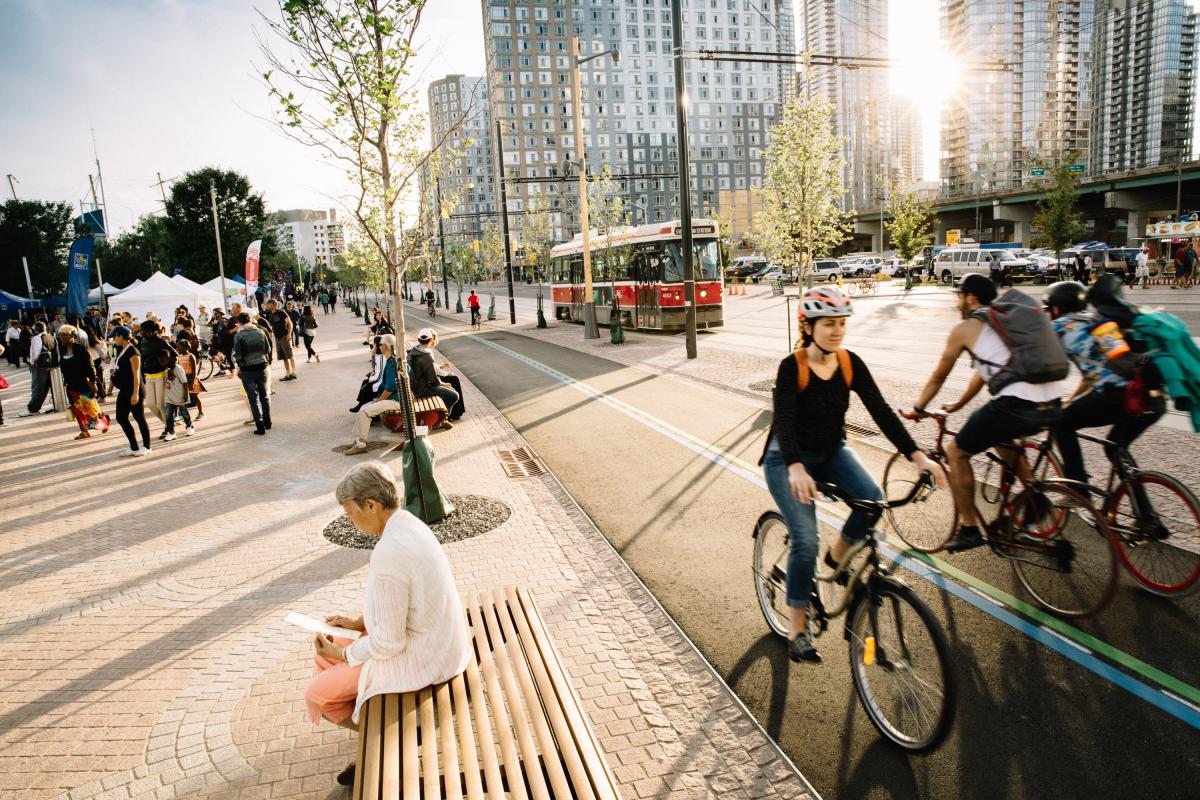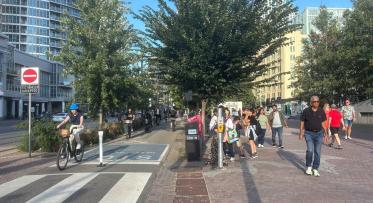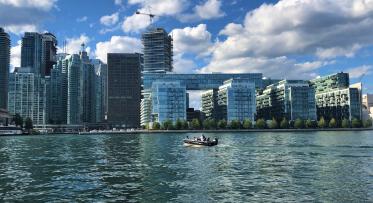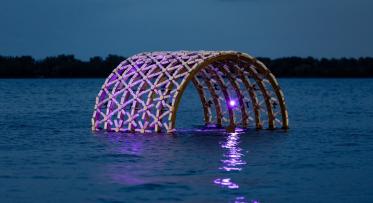Touring the Toronto waterfront at North America’s leading transportation conference
Image of the revitalized Queens Quay West back in 2015. (Image by Connie Tsang)
By: Meghan Hogan
There’s been a real buzz in Toronto this week and it’s not just about the Toronto International Film Festival. Throughout the week you may have noticed fleets of cyclists and pedestrians congregating near the Sheraton Hotel on Queen Street. Your first thought may have been that they were secretly seeking out celebrity sightings, but in reality, hundreds of people from Canada and the United States were participating in the National Association of City Transportation Officials’ 2019 Designing Cities Conference. Now that’s quite a mouthful so from here on we’ll simply refer to it as the NACTO Conference.
NACTO is an association of 81 North American cities and transit agencies that exchange transportation ideas, insights, and practices to tackle transportation issues. And every year, NACTO hosts the Designing Cities Conference, which brings together more than 900 officials, planners, and practitioners to advance the state of transportation in cities.
This year’s conference was held in the heart of Canada’s largest city. Participants joined workshops, panel discussions, presentations and breakout sessions covering a wide range of topics from building transit-friendly signals and complete cyclist networks to managing people-focused street events and strategies for a low carbon future. There were also WalkShops to give everyone a chance to explore some of Toronto’s major streets, landmarks and public spaces.
As a sponsor for this year’s NACTO conference and an organization recognized for its leadership in city-building, we were thrilled to lead two WalkShops across waterfront neighbourhoods.
 A WalkShop led by Waterfront Toronto and the City stopped by Sugar Beach in East Bayfront. The park opened in 2010 – look at these beautiful trees!
A WalkShop led by Waterfront Toronto and the City stopped by Sugar Beach in East Bayfront. The park opened in 2010 – look at these beautiful trees!
At Waterfront Toronto, we’re working to deliver an exceptional waterfront for everyone to enjoy. To accomplish this, we’re focused on creating new waterfront neighbourhoods that provide the support and amenities people need to thrive. This includes building high-quality parks and public spaces (25 per cent of the waterfront area is reserved for it, in fact) that respond to local needs and strengthen the broader urban fabric, and important infrastructure like roads, cycling amenities, and transportation links to the rest of the city.
Both WalkShops were presented in partnership with Toronto City Planning and had a strong focus on urban regeneration. Pina Mallozzi, Vice President of Design at Waterfront Toronto, began by leading a tour of Toronto’s central waterfront and East Bayfront neighbourhood. The tour highlighted design choices and best practices that help our organization transform industrial lands for the greater public good, creating more connections to water, green spaces and a mix of uses for healthy communities. Participants were led through a series of cultural attractions and dynamic public spaces as they walked along the revitalized Queens Quay, which was transformed in 2015 from an uninviting traffic corridor into a waterfront destination that now accommodates vehicles, dedicated Light Rail Transit, a large pedestrian promenade and a multi-use trail.
 Brett Howell from the City of Toronto Waterfront Secretariat talks to WalkShop participants near the Garrison Crossing next to The Bentway.
Brett Howell from the City of Toronto Waterfront Secretariat talks to WalkShop participants near the Garrison Crossing next to The Bentway.
The second WalkShop took cyclists along the waterfront, highlighting mobility and transportation projects that have contributed to the area’s ongoing development including the Martin Goodman Trail along Queens Quay, the new pedestrian and cycling bridge connecting Fort York to nearby neighbourhoods, The Bentway, Trillium Park and East Bayfront. Members of our Planning and Design team spoke to how transportation plays a key role in creating connections to and through developing communities, and how we address the challenges that come with creating complete streets for diverse road users.
Coming together with professionals from across North America – so many of whom are facing the same challenges we’re tackling – was a great chance to share ideas, collaborate and learn. We’re thankful to NACTO’s event organizers for the opportunity.




